Juventus and Inter arrived at the game with one aim: victory. Both teams were in the race for an objective and anything less than a win would have compromised Juve’s chances to win a Scudetto and Inter’s odds to reach a Champions League spot. The final 2-3 result in Juve’s favour at Inter came from a characteristic performance by the visitors, who just scraped by the three points with two last minute goals. Despite being one man down for more than 70 minutes Inter put up a worthy fight, troubling Juventus and Spalletti proved once again why, tactically, he’s one of the best managers in Serie A.
Juventus lined up in a 4-3-3 which saw Buffon start behind a backline composed of Cuadrado, Barzagli, Rugani and Alex Sandro, whilst Khedira, Pjanić and Matuidi starred in midfield; Douglas Costa, Higuaín and Mandžukić led the frontline.
Inter shaped in their usual 4-2-3-1 with Handanović in goal; Cancelo, Miranda, Škriniar and D’Ambrosio in defence; Vecino and Brozović in the double pivote and Candreva, Rafinha and Perišić behind the lone striker Icardi.
Inter’s attacking structure
Inter’s 4-2-3-1 shape perfectly suited Juve’s 4-3-3/4-5-1, handing the bianconeri naturally formed man-orientations across the pitch. Therefore, to create positional and numerical superiority situations Candreva was positioned in the left half-space, aside Rafinha, – whilst still having positional freedom to roam to the ball-side – to create a 2v1 between the lines against Pjanić and a rhombus comprising Brozović , Perišić and Rafinha.
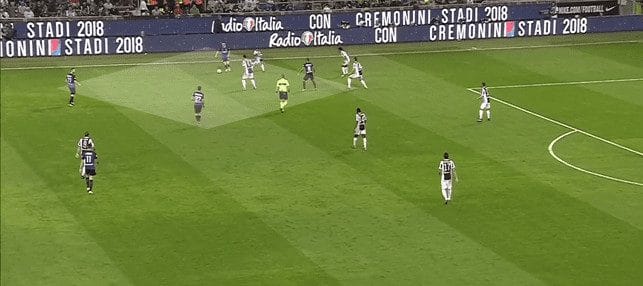
Candreva occupies the left half-space and creates a connection rhombus
Furthermore Candreva would drop deep to act as a free-man thus facilitating Inter’s build-up.
With Candreva occupying infield positions, Cancelo was in charge of providing width on the right-hand side whilst being allowed to engage in 1v1 duels against Alex Sandro, due to Mandžukić having been drawn out of position by the Italian winger; this scenario was particularly visible on switches of play.
Inter’s attacking structure allowed it to stretch the opposition and utilise the entire length of the pitch as well as creating numerical superiority situations and overloads to progress and retain possession.
Juventus’ attacking plan
Juve’s offensive game plan was somewhat similar to Inter’s, however it relied on switches of play and overloads more compared to the home side. Allegri had found in Cancelo Inter’s weak link, and therefore focused on creating decisive problems for the Portuguese through overloads on the left flank with Mandžukić positioned in the half-space, Alex Sandro on the wing and Matuidi making runs on Cancelo’s blindside; these runs would either attract the midfielder, the centre-back or the right-back, creating 2v1 situations.
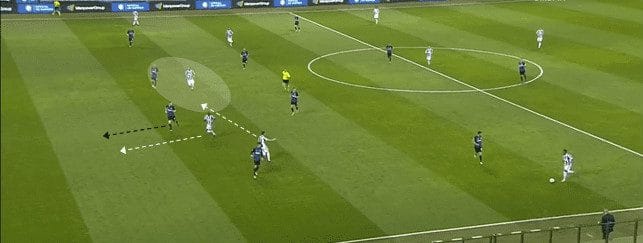
Matuidi’s run draws Škriniar into depth and by cutting inside Mandžukić achieves a 2v1 against Miranda
The image below shows how Cancelo was caught in two minds due to Juve’s overloads, leaving Mandžukić free on a Cuadrado cross to the back post.
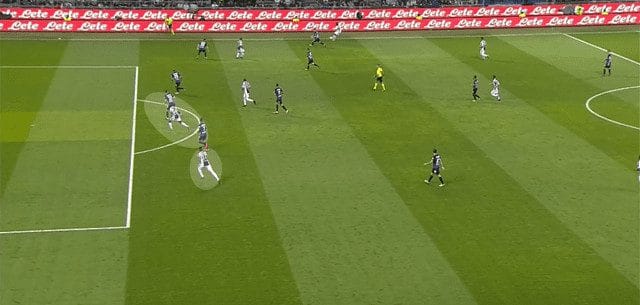
Cancelo follows Matuidi leaving Mandžukić unmarked
To even out the attacks on both sides Costa probably could have occupied the half-space with Cuadrado overlapping in order to take away the marker from the Colombian.
Inter’s man-oriented pressing
Seeing Juve’s struggles to build-up play against good pressing sides Spalletti adopted a man-oriented pressing style in a 4-4-2, looking to mark every passing option and press the player in possession. The pressing pattern saw the ball-side winger press the full-back, the two strikers press the centre-backs, the ball-side pivote press Pjanić and the ball-far winger press the ball-far centre-midfielder.
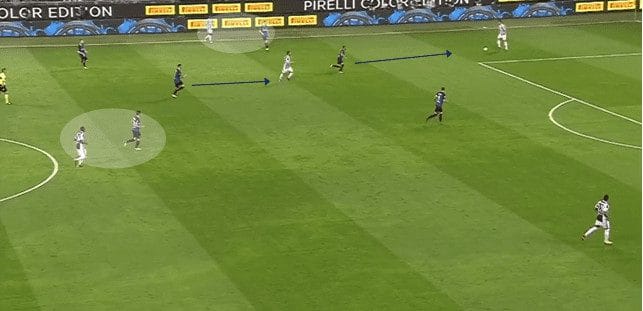
Inter’s man-oriented pressing
To evade Inter’s man-oriented pressing, Juventus tried to progress through the passing triangles formed by their 4-3-3 structure, eased by a poor application of the aforementioned pressing pattern.
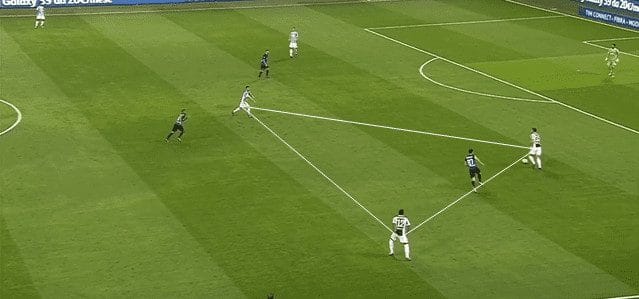
Rafinha presses the wrong man and the ball-side pivote doesn’t step out on Pjanić creating a 2v3 situation
Whenever a progression through passing triangles wasn’t possible, Juve resorted to long-balls to Higuaín who’d drop in the space between the defence and midfield, – which lacked vertical compactness due to Inter’s centre-back’s tendency to retreat instead of stepping out – breaking Inter’s lines of pressure.
The game after the red card
Following Vecino’s red card the tactical plans inevitably underwent changes: Inter, being one man down, regrouped in a horizontally and vertically compact 4-4-1 by dropping Rafinha into the midfield line whilst Juventus kept following their initial script, constantly switching play and looking to open passing lanes into Zone 14, occupied by Higuaín and Khedira.
However, despite the one man advantage, Juventus failed to effectively disorganize Inter’s structure, making its possession sterile by creating little to no positional superiority situations or goal-scoring chances. Another aspect in which Juventus didn’t exploit the red card was their man-oriented pressing. Throughout the season its pressing has often left much to be desired and Saturday night was no different. Often Juventus would misjudge the timing of the pressing, arriving late and consequently allowing the opponent time on the ball to find a free teammate and progress through Juve’s stretched lines.
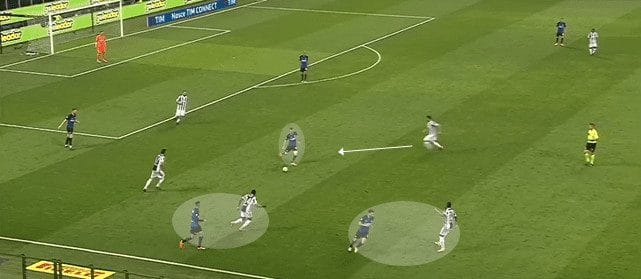
Khedira times his pressing run badly allowing Brozović time to pick a pass and find Rafinha
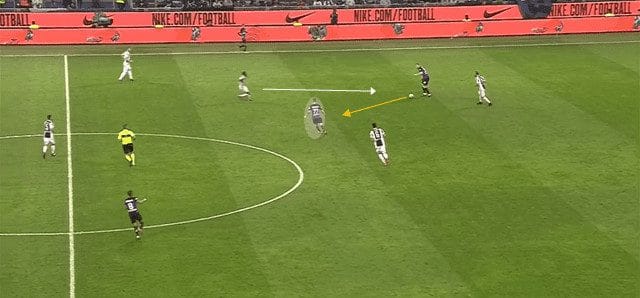
Khedira falls for Škriniar’s body feint and starts to press Miranda, leaving Brozović unmarked
After Icardi’s equaliser, and perhaps too late, Allegri made the two necessary changes to manipulate Inter’s structure: Dybala in for Khedira and Bernardeschi for Mandžukić, moving Costa to the left flank, therefore switching to a 4-2-3-1 and partially solving the zone occupation and spacing problems mentioned when talking about Juventus’ attacking structure; moreover, the substitutions added technical ability and responsibility. As explained in the post match interviews by Allegri, in these moments, when a team is struggling and there’s little time left what counts are talented players that can change the game with a piece of skill and not automatism’s. Dybala added a man between the lines (although he was rarely reached by his teammates due to Inter’s vertical compactness) whereas Bernardeschi occupied width, Cuadrado the half-space, or viceversa, depending on the position of the ball.
In the final minutes of the match, Spalletti set up his team in a compact 5-3-1 deep block with Perišić as a striker. This way, however, the Inter manager deprived his team of Icardi, a striker capable of holding up the play, and, due to fatigue, Inter couldn’t progress up the field anymore, allowing Juve to maintain long spells of possession and continue its attacks.
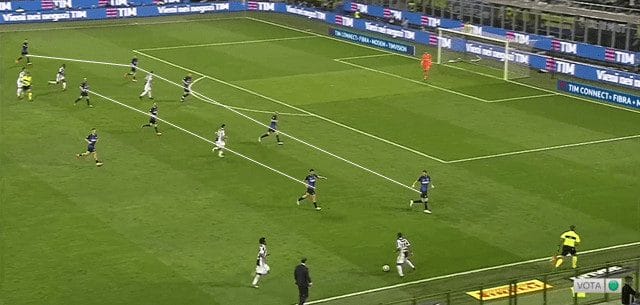
Conclusion
Škriniar’s own-goal and Higuaín’s winner both came from Santon’s mistakes (who lost his marker twice) following two brilliant pieces of skill by Dybala, showing yet again, why mental resilience and individual quality make the difference in difficult moments. Qualifying for the Champions League becomes tough now, with Lazio four points ahead, Spalletti’s side and Interisti will have to hope for a Lazio breakdown, maybe due to Immobile’s season ending injury. Juventus, on the other hand, with Napoli’s loss in Florence, move one step closer towards the seventh Scudetto, showcasing, however, the tactical issues that have troubled them this season and their inability to control games defending. It’s been an electrifying Scudetto and Champions League race and these last weeks of Serie A seem as though they’ll be more thrilling and decisive than ever.






Comments